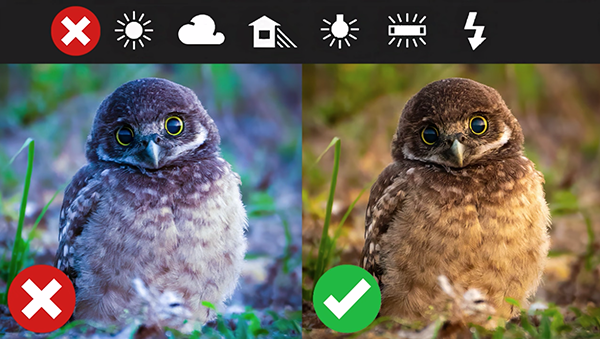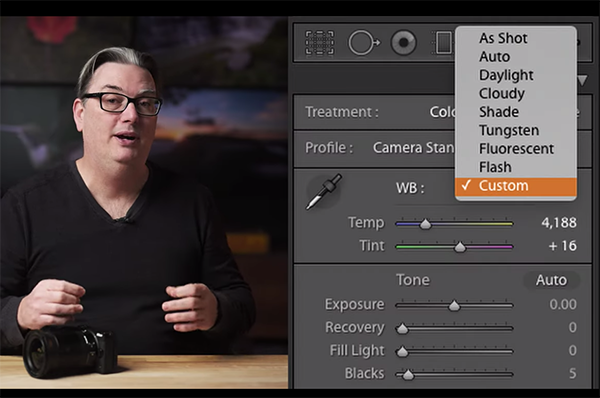Domke Sling Bag & Tech Pouch from Tiffen
50 Years of Domke
It’s very hard to believe that it’s been nearly 50 years since Philadelphia Enquirer photographer Jim Domke conceived and created the first iconic Domke bag. In 1976 the working photojournalist developed a camera bag to suit his own needs and it evolved into the classic Domke F-2 shoulder bag. The Philadelphia Inquirer eventually bought bags for 22 staff photographers and his creation became a business. In the process he created a product family that’s sold about one million units and is used by photographers around the world. I once joked, more than half-seriously, that I’ve been in photography so long I’ve nearly worn out my first Domke F-2.
 The company that owns and distributes Domke products is The Tiffen Company, the legendary photo and video accessory brand that was established in 1938. The Tiffen Company has earned numerous awards from the Academy of Motion Picture Arts & Sciences, as well as multiple EMMY Awards from the National Academy of Television Arts and Sciences, and the Academy of Television Arts and Sciences. In addition to Domke, Tiffen’s stable of brands includes Steadicam, Lowel location lighting, Davis & Stanford, Stroboframe, Zing and Tiffen Filters.
The company that owns and distributes Domke products is The Tiffen Company, the legendary photo and video accessory brand that was established in 1938. The Tiffen Company has earned numerous awards from the Academy of Motion Picture Arts & Sciences, as well as multiple EMMY Awards from the National Academy of Television Arts and Sciences, and the Academy of Television Arts and Sciences. In addition to Domke, Tiffen’s stable of brands includes Steadicam, Lowel location lighting, Davis & Stanford, Stroboframe, Zing and Tiffen Filters.
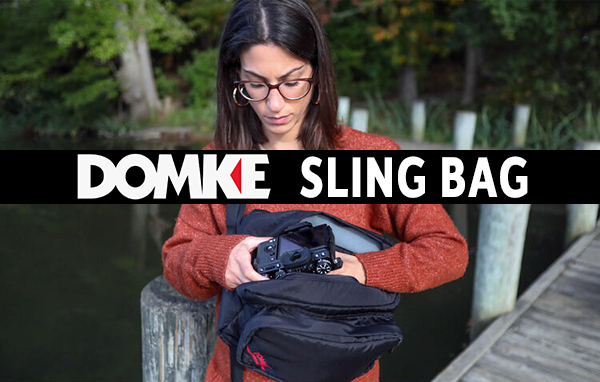
Domke Sling Bag
Better than a photo backpack for all but the longest treks, and more spacious than a shoulder bag, the Domke Sling Bag is carried comfortably in the center of the user’s back by a single strap and can be rotated into the working position quickly and effortlessly. It comes with a detachable torso-fitted stabilization strap so you can secure it if you’re moving quickly. The main strap is fully adjustable and is wider at the top, and padded for comfortable all-day carry. At the widest point there’s a handy double-stacked pocket suitable for a pen, sunglasses, business cards or press pass. Overall, the Domke Sling Bag is supremely functional and comprises a very snug and stable configuration.
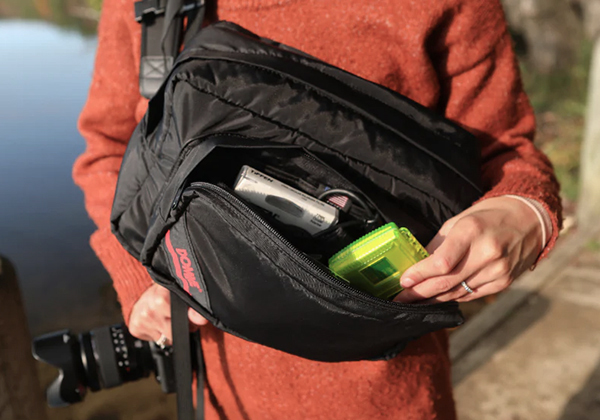
The capacity is 6L (Liters). One L equals 61.02 cubic inches, slightly smaller than a cube that’s 4 x 4 x 4 inches. The volume of a standard half-gallon milk carton is about 1.9L, so judge accordingly. The Domke Sling Bag also accommodates an 11-inch tablet (or paper notebook if you’re still partly analog like I am).
Inside we find two repositionable dividers and a soft, smooth, snag-free gray lining. On the outside there’s a large zippered pocket. YKK zippers, of course. Inside that pocket are three full-width open pockets and three full-width zippered pockets. One open pocket has five elastic loops to secure spare batteries, memory card cases, a couple Snickers bars or other similarly sized objects. There’s also a secret pocket for Apple AirTags but I haven’t found it yet.
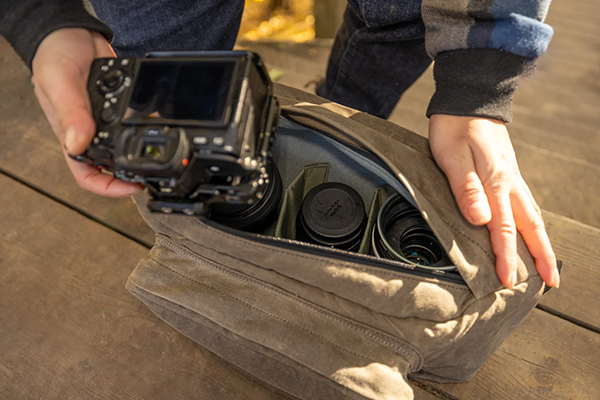
This is the best organizational setup I have ever encountered in a camera bag. I’m so glad it doesn’t have the useless ballpen loops or ridiculous snap for car keys. Do any photographers really carry their car keys inside their camera bag? Why not your cellphone, too. Then if your bag is stolen you’re totally helpless.
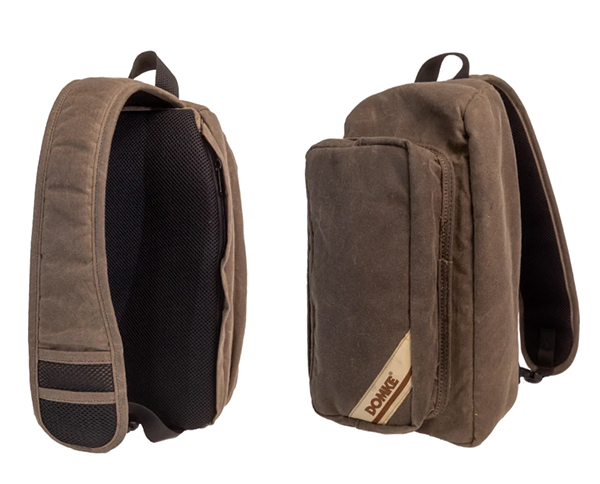
The outer fabric is your choice of black ballistic nylon or brown waterproofed canvas (i.e., RuggedWear). The latter version is better looking in my book. It comes with a can of Refinishing Wax so you can maintain the weather resistant protection.
Domke Sling Bag Key Features
• 6L storage capacity
• Durable water resistant construction
• Padded camera compartment with adjustable dividers
• Padded zippered pocket accommodates 11-inch tablet
• Zippered front compartment with six interior pockets and elastic loops
• Detachable torso-fitted stabilization strap
• Permanently attached padded shoulder strap
• Handy haul-or-hang handle on top
• Padded back with breathable mesh ventilation
• Well-hidden AirTag pockets
• YKK zippers throughout
• Made in the USA
• Measures 14.5 x 8 x 8 inches (37 x 20 x 20 cm)
• Weighs (estimated) about one pound (.45 kg)
The new Domke Sling Bag is available in Black Nylon ($119.99) and RuggedWear Brown ($139.99) and can be ordered directly from Tiffen.
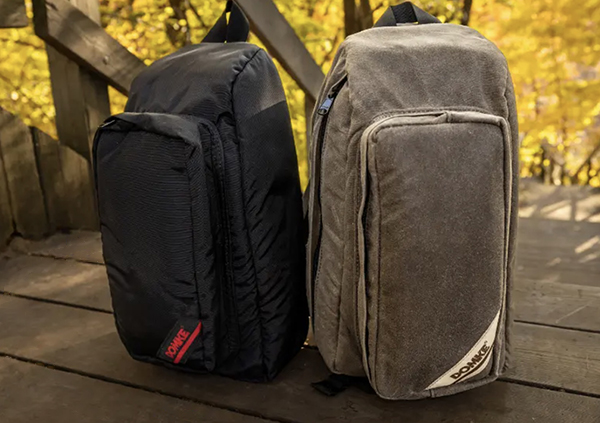
In the Field
The Domke Sling Bag reminds me in many ways of one of my favorite Domke bags, the stalwart F-5XB. The Sling Bag is larger and holds more than my F-5XB, and it’s extremely comfortable to carry. It’s roomy—my Fujifilm X-T5 with lens plus three more lenses, flash and an assortment of accessories fit comfortably with no suggestion of overload.
One example of the high quality construction can be found by examining the point where the thinner part of the shoulder strap is attached to the wider part. It’s double stitched at the end and also further secured by a line of stitching in the shape of an “X” surrounded by a rectangle. Nice.
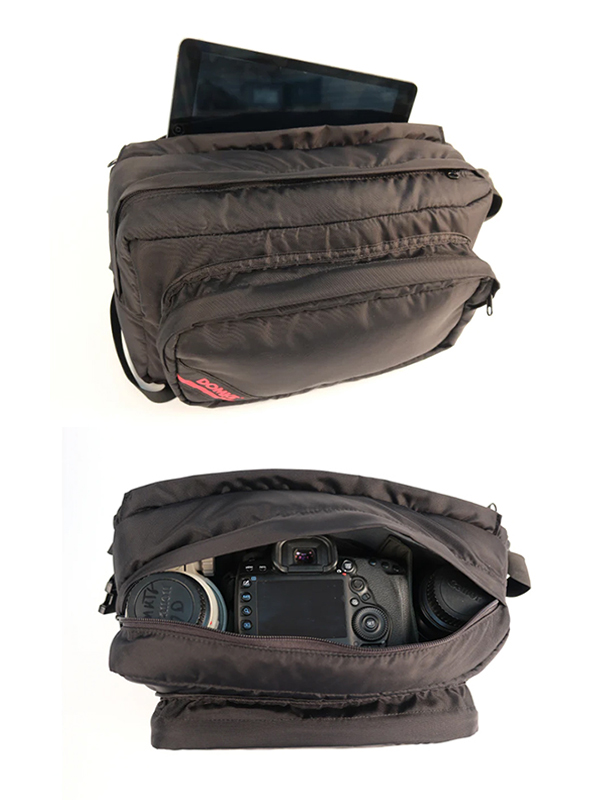
The Sling Bag is comfortable to carry all day. Because it rides on the back, it doesn’t falsely mark me as a suspected shoplifter when I walk into a store. And because it can be quickly slung to the front to access the contents, it’s convenient and highly functional.
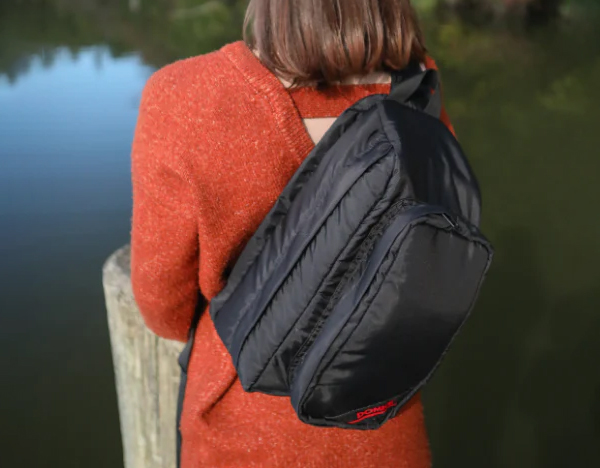
Conclusion
The Domke Sling Bag has one of the most useable and logical designs I’ve seen. Whether navigating the urban street jungle or strolling through the local nature center, it’s absolutely a pleasure to use. The adjustability makes it flexible to wear, even over a jacket or parka (it was 12 °F here last week).
I recommend it. The construction is meticulous and the layout is common sense.
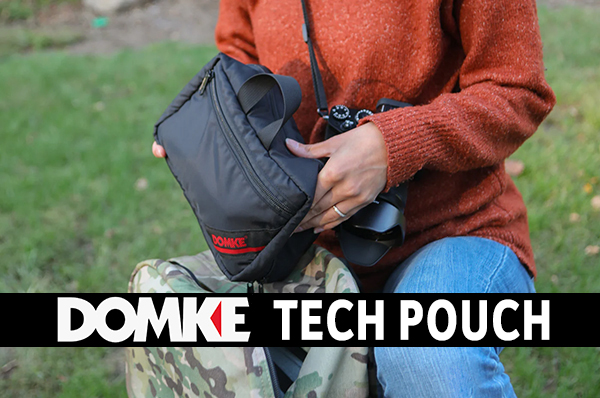
Domke Tech Pouch
Use the new Domke Tech Pouch to organize all of your small accessory items (e.g., memory cards, portable drives, batteries, cables, chargers, tools, snacks and more) so everything can be easily found and readily accessed. It’s compact, just 10 x 6 x 4 inches (25 x 15 x 10 cm), but holds an amazing amount of gear. And it’s just the right size to carry inside your photo backpack or shoulder bag.
Because it lays flat, it’s convenient to use. With a variety of sizes of both solid and mesh pockets, there’s a place for everything and everything stays is in its place. Although I personally have not used one, I hazard to say that it has useful applications beyond photography and videography. I can imagine packing my traveling fly-tying tools, a small computer repair kit or even a high tech shaving bag.
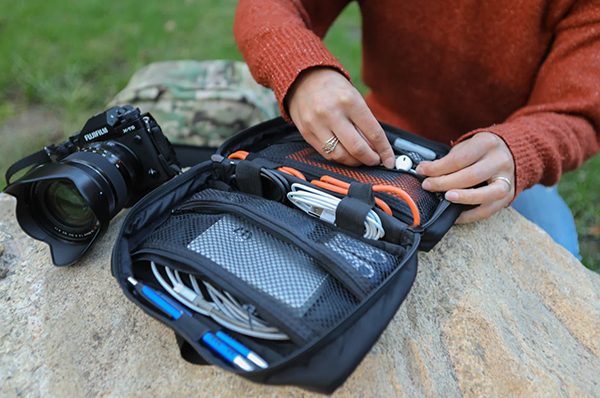
My only wish is that Tiffen would produce the Domke Tech Pouch in high-visibility orange or yellow colorway. Black ballistic nylon is a fine old standard, but it’s a bit boring. Another option—18% gray so it could be used as an ad hoc gray card for white balance adjustment. I’m probably a choir of one with these opinions.
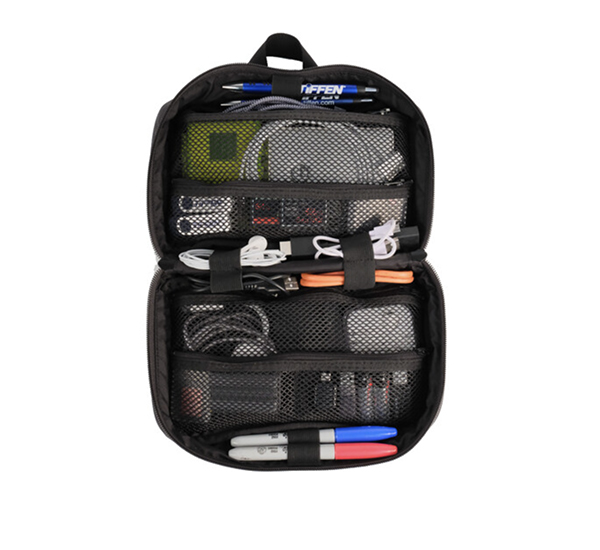 Domke Tech Pouch Key Features
Domke Tech Pouch Key Features
• Black ballistic nylon construction
• Full wrap-around YKK zipper, opens flat
• Four zippered mesh compartments
• Two external zippered pockets
• Small and large elastic loops to secure small accessories
• Hidden Apple AirTag pockets
• Handy haul-or-hang handle on top
• Measures 10 x 6 x 4 inches (25 x 15 x 10 cm)
• Weighs .45lb (0.2 kg)
The new Domke Tech Pouch comes in basic black and can be ordered from Domke for $49.99 which, frankly, is much less than I had expected. It’s an outstanding value.
Genesis of the Domke Sling Bag and Tech Pouch
Like the original Domke F-2, the Sling Bag and Tech Pouch were both born of need. Tiffen listened very carefully to their customers.

“The Sling Bag and Tech Pouch were both created for content creators and photographers by these exact groups of people,” Andrew Tiffen, senior vice president and chief operating officer at Tiffen told us. “Many complained about the current models on the market and wanted something better, so every element was designed with a specific reason to give them a better product.”
Made in USA
Domke bags are proudly made in the USA. That means a lot to me personally. Offshore fabrication is often cheaper but rarely equal in quality.
Beware Knockoffs and Counterfeits
The original Domke innovations are protected by US Patent number 4,260,004 but that doesn’t stop some interlopers from stealing the design, producing inferior products in third-world sweatshops and offering them online. Because I don’t speculate, I purchased two of these knockoffs, and I can attest that they are nowhere near Domke’s quality. In fact, one had parts stitched in backwards. Genuine Domke bags are manufactured to the highest standards right here in the USA, so look for the proud American flag label.
My Favorite Domke
Some camera carry solutions are better suited for certain photo activities than others, which is why no photographer I know owns only one bag. You can eat soup with a fork, but a spoon is more rewarding. Read our Buying Guide to learn the 10 characteristics we consider when bag buying: How to Buy a Camera Bag.
I’m often asked which Domke bag I prefer. While I use my Domke F-2 often, and my Domke F-5XB even more often, my overall favorite for serious work is the Domke F-10.
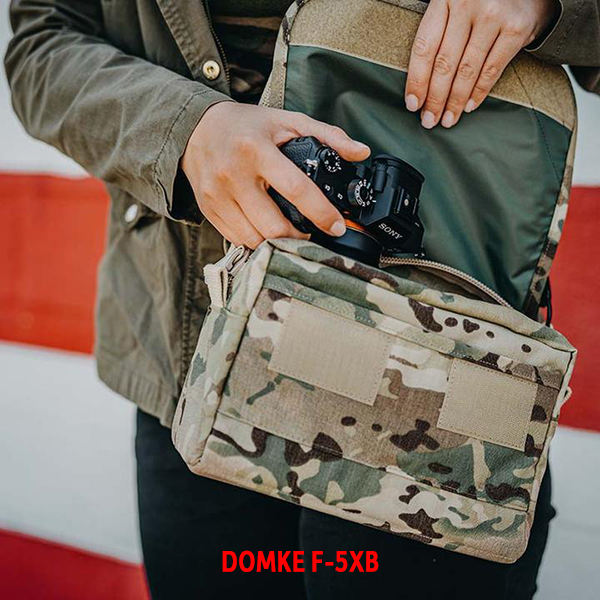
It’s just a little larger than the F-5XB but holds more, has a very useful large pocket on the front that closes tight with a zipper, an open pouch-pocket on the back, and one sturdy steel snap that holds it closed (in addition to a strip of hook-eye fabric). There’s also a zippered pocket on the back of the front flap. I added a Domke accessory shoulder pad (Domke FA-031 U.S. Post Office Shoulder Pad) to pamper my aging trapezius (shoulder) muscles, but the wide strap has gripper strips along the full length so slippage is never an issue even without the pad.

The Domke F-10 weighs just 1.5 pounds (0.7 kg) and measures 11.5 x 9 x 6 inches (29.21 x 22.86 x 15.24 cm). It’s small enough to be inconspicuous and large enough to hold everything I need when I’m out and about. You can order one today from Tiffen in Black, Olive, Sand or Khaki for $135.
Tiffen Outlet
Psst! If you’d like to score a bargain, Tiffen hosts an Outlet Store on their website. Save up to 80% on an ever-changing assortment of professional photo, video and lighting products from across Tiffen’s various brands.
If You Enjoyed This Article
Click here to choose from more than 500 reviews, how-to articles, quizzes, attempts at humor and other alleged insight into the world of photography written by yours truly.
Become a Member of the Shutterbug Community
Register for a free account. Sign up for our newsletter. Find us on Facebook. Spend five minutes (or less) uploading your best shots once every week or so to our gallery section. Potentially become a Shutterbug Photo of the Day winner. Enjoy viewing the fantastic work being done by thousands of photographers all over the world—and add your images to the enduring collection.
—Jon Sienkiewicz




